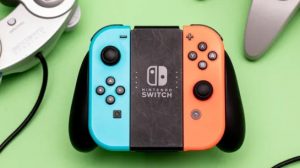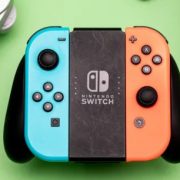The Nintendo Switch showed us we deserve more from joysticks
Jan 31, 2023,

Every evening, my kids beg for “Mario,” and I know what that means — watching their old man wrestle with a pair of Nintendo Switch Joy-Con controllers while hopefully saving a princess. It’s not always easy timing tricky jumps in Super Mario 64 and Super Mario Sunshine, especially not when the controls are fighting you.
That’s not a lame dad excuse: we beat both games, and we’re on to Super Mario Galaxy now. But I can’t count how many times Joy-Con drift sent my mustachioed plumber plunging to his doom. When my left Joy-Con died, Mario started walking off edges all by himself. Now, my right Joy-Con is a distracted boyfriend meme, its erroneous joystick signals always aiming me in the wrong direction. This’ll be my third set of Joy-Cons in five years, and I’ve had enough.
At times like this, it’s easy to forget: Nintendo’s tiny joysticks were a minor revelation when they first came out.
While Sony may have shaped the modern video game controller, it was Nintendo that pioneered the D-pad / face button layout — and Nintendo that popularized the analog joystick that forms the core of most every gamepad today. In 2017, Nintendo arguably did it again with the Switch: it introduced the first handheld that was also a full-fledged TV console, complete with a fully functional miniature joystick.
:format(webp)/cdn.vox-cdn.com/uploads/chorus_asset/file/24383777/236495_Nintendo_Joy_Con_Joystick_BOTM_AKrales_0130.jpg)
The Nintendo Game Boy, Game Boy Advance, and Nintendo DS didn’t have joysticks at all. The PlayStation Portable and Nintendo 3DS made do with sliding thumbpads. Even the PlayStation Vita, which finally introduced competent dual-analog control to handhelds, still didn’t let you press its joysticks in to sprint or slide or zoom.
The Nintendo Switch changed that — and not with an off-the-shelf component. As far as I can tell, Nintendo and its manufacturing partner Hosiden created the low-profile clickable joystick that ships with every Switch console.
:format(webp)/cdn.vox-cdn.com/uploads/chorus_asset/file/24383773/236495_Nintendo_Joy_Con_Joystick_BOTM_AKrales_0040.jpg)
In January 2014, a Hosiden engineer named Mitsuhiro Asano filed for one of what would become several patents on such a joystick, and by October 2015, he was just one of many names on a joint filing between Nintendo and Hosiden for this “multi-directional input device”:
Inside and out, it looks like a dead ringer for the Nintendo Switch joysticks we have today, right down to the novel ball joint-like shafts that interlock with the joystick — instead of the typical gates. For comparison, here are the insides of a real Joy-Con joystick.
I should tell you: it’s highly unusual for companies to reinvent the joystick. As iFixit discusses in this story, the dirty little secret of gamepads is that their joysticks are all the same: the PS5, PS4, Xbox One, Xbox Elite, and even the Nintendo Switch Pro controllers all use an identical Alps joystick, a “ThumbPointer” RKJXV. Perhaps the Joy-Cons use something else because Alps doesn’t sell a low-profile clickable joystick; while its smaller RKJXY might be the right size for a Switch, it can’t be pressed down like a button.
All this makes me wonder whether Nintendo’s Joy-Con joystick designers might have overlooked something — something that might explain why they keep failing at a rate so steep that the Switch has become the poster child for the drifting joystick phenomenon.
:format(webp)/cdn.vox-cdn.com/uploads/chorus_asset/file/24397621/PS5_DualSense_5_1536x1152.jpg)
See, the Joy-Cons aren’t the only joystick controllers that can suffer from drift; all those Alps sticks in Sony and Microsoft gamepads can, too. Any potentiometer-based joystick can and likely will wear out the resistive strips it uses to measure how far the stick is tilted. (Alps quotes an operating life of 2,000,000 cycles, which iFixit says can work out to just 417 hours of use.)
And while Nintendo seemed to publicly suggest in 2021 that nothing can be done, Sega famously fixed this decades ago with the Dreamcast and Saturn 3D by using Hall effect joysticks instead, which measure magnetic fields that don’t require direct physical contact. Some boutique firms are now rolling out controllers and portable PCs and even thumbstick replacement kits for your Steam Deck or Switch that use Hall effect as a selling point.
:format(webp)/cdn.vox-cdn.com/uploads/chorus_asset/file/24397538/6065826.jpg)
And gamers are paying attention. Now, when Sony releases a new “pro” controller with plain ol’ potentiometer sticks, not even a new incredibly easy to replace toolless joystick module will save the company from critique. Nintendo got its fair share of flak when shipping the Nintendo Switch OLED with the same drifting sticks, too. I wouldn’t be surprised if next-gen consoles raise the bar to avoid getting lumped in.
When I really think about it, I need to thank Nintendo twice for these joysticks: once for creating the push-button low-profile stick and again for drawing the world’s attention to an issue plaguing our peripherals for decades. The Switch showed us we deserve more.
To this day, Nintendo will replace your drifting Joy-Cons for free. I’ve done it three times now, but I’m ready to move on. There’s a screwdriver calling my name, ready to help me swap a pair of GuliKit sticks into my very own Joy-Cons.
Source:The Nintendo Switch Joy-Con showed us we deserve more from joysticks – The Verge




